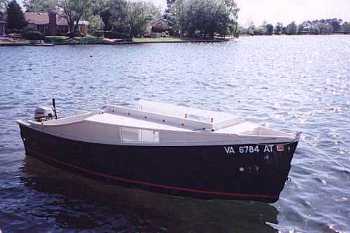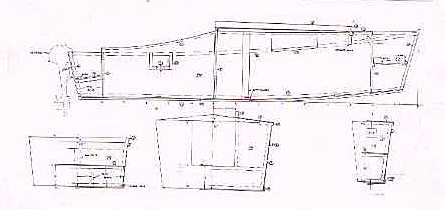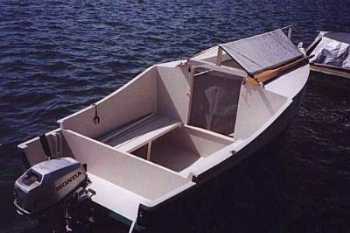Jim Michalak's Boat Designs
1024 Merrill St, Lebanon, IL 62254
A page of boat designs and essays.
(1 March 2023) We cover small boat rudders. The 15 March issue will cast rudder sink weights.
REND LAKE MESSABOUT 2023...
...Lets try it again. Rend Lake 2023 will take place on June 9 and 10, always on the weekend before Father's Day weekend. I promised to remind all of us to try to get the good campsites. They are sites 24 through 30 and especially 26 through 29 if possible, this at the North Sandusky campground at Rend Lake.
ORDER NEWS
THE BOOK IS OUT!
BOATBUILDING FOR BEGINNERS (AND BEYOND)
... is out now, written by me and edited by Garth Battista of Breakaway Books. You might find it at your bookstore. If not check it out at the....
ON LINE CATALOG OF MY PLANS...
...which can now be found at Duckworks Magazine. You order with a shopping cart set up and pay with credit cards or by Paypal.
ALSO...In addition to the Duckworks downloads I also now have access to a large format inkjet printer which is making very nice full sized prints on paper. So I can return to what I started 30 years ago, you order direct from me by snail mail using the address above only with cash or check in US funds with the prices shown on this website, and I mail you full sized 2'x 3' paper prints. The price includes first class mail to US and Canada.
SMALL BOAT RUDDERS
BACKGROUND...
Here is an article I wrote a while back that appeared in the great paper magazine BOATBUILDER. I've included copies of it in my prototypes catalog since then. The article shows how I've made rudders for my own small boats.

Where I sail only a kick-up rudder works well. It's not because once a year you might strike a ledge and break off a fixed rudder. It's because our waters are generally shallow and a fixed rudder would require endless fussing on every trip. With the weighted kick-up rudder shown here you just blast along without giving the kick-up blade a second thought.
I have also tried kick-up rudders that weren't weighted, but were held down by lanyards. Nearing a shore or shallow I had to play the thing like a puppet and quickly ran out of hands because the tiller, sheet, and board all needed handling at the same time. The weighted rudder blade is much better. In this article I'll show you how I build a kick-up rudder from the ground up from plywood. This sort of rudder can be suitable for boats up to about 22 feet length.
RUDDER BLADE...
The best way to make the blade is to laminate it from thinner plywood. I've seen warped blades made from a single piece of 1/2" plywood, but I've never had a problem with a blade built up from two layers of 1/4" plywood.
Cut out the plywood blanks and butter one up with glue. I prefer plastic resin glue. It comes as a dry powder and is mixed with water to the consistency of regular white wood glue. It's best to spread the glue with a notched trowel like you use to paste down floor tiles. Place the glued-up blanks together on a flat surface protected with plastic or paper, and tap a couple of light nails through them so they can't slide around on each other. Apply clamping pressure with weights like concrete blocks placed atop the blanks. Now stay away until the glue has set good and hard.
Now give the blade a final trimming and streamline the edges where required. (If your rudder, daggerboard, leeboard or centerboard vibrates in use, streamline the edges some more. That almost always cures the ailment.)
SINK WEIGHT...
I called this the "counterweight" in the drawing but "sink weight" is a better term.
The sink weight should be slightly heavier than the buoyancy of the immersed blade. Wood is about half as dense as water, and lead is about 11 times denser than water. It works out that the area of the lead weight should be about 1/16th the area of the immersed blade, or maybe 7 percent of the area to give a slight negative buoyancy. For example, a blade that is 10 inches by 15 inches immersed is 150 square inches. The lead weight could be 150 x .07 = 10.5 square inches, which would be a square 3.24 inches per side. Cut a hole in the blade for the lead to the proper size, preferably toward the tip and toward the trailing edge. Bevel the hole's edges so the lead will lock in place by forming flanges around the blade. Also place some rustproof nails or screws around the interior of the hole to further lock the lead in place. Clamp the blade to a flat metal plate and place it level on the floor.
To figure the weight of the lead required, multiply the area in inches by the thickness in inches and again by .4. In the example, if the example blade is 3/4" thick, the weight of the lead required is 10.5 x .7 x .4 = 3.15 pounds.
To melt the lead, I use a propane camp stove. I place it right next to the job so I woun't have to tote molten lead around the shop. For a crucible I use a coffee can with a 1/2" pour hole drilled about 3" above the bottom of the can, with a long metal handle bolted to the side of the can. The crucible goes on the stove with enough lead wheel weights inside sufficient for the pour.
Begin the pour as soon as the lead is molten. (The steel clamps on the wheel weights will float to the top and not pass through the pour hole.) Take your time and be very careful with the pour, but it must be done all at once. Overfill the hole in the rudder blade somewhat to allow for shrinkage on cooling. Shut off the stove and walk away from the job for a few hours. Lead stays very hot long after it has solidified.
If the weight gets loose in the blade due to shrinkage, you can tighten it by placing the weight over an anvil and hitting the lead with a hammer. That squeezes the center and expands the perimeter.
Now contemplate what it's like to pour a thousand pound keel!

RUDDER STOCK...
Laminate this exactly as you did the rudder blade. You need to add the downstop and it's amazing to me how sturdy this part needs to be. A block of hard rubber or phenolic plastic bolted in place might be best.
TILLER/HOIST LANYARD...
Don't make the tiller too short! Make it too long and shorten it later if needed. The tiller should fold neatly along the back edge of the rudder for storage.
Use light braided line, about 3/16" for the lanyard. Tie it to a small hole in the rudder's trailing edge. The hole needs to be located about where the raised rudder meets the aft end of the tiller. Then pass the lanyard through a hole in the back corner of the tiller, then forward to a small cleat on the top of the tiller. Pass the lanyard through a small hole in the base of the cleat and tie and loop for your fingers. To raise the rudder, yank on the lanyard and belay it around the little cleat. To lower the rudder, uncleat the lanyard and let the blade drop kerplunk against the stop.
SHEET FAIRLEAD...
This works very well on smaller sails that don't require multipart main sheets. Screw a fairlead solidly to the tiller's top face. Place the fairlead right above the rudder hinges so the sheet loads won't affect steering. Run the sail's sheet through the fairlead and forward along the tiller. You can secure the sheet merely by wrapping it a couple of times around the tiller's grip under your steering hand. Then you can steer and hold the sheet with the same hand. To release the sheet in a puff you need only slacken your grip without letting go of the tiller. You can also belay the sheet around the rudder lanyard cleat if you are feeling lucky.
HINGES...
I haven't figured out hinges yet. I think the best ones are welded up from stainless steel, but I'm working towards building boats totally from lumberyard stuff. Stevenson Projects used barrel bolt locks for hinges. Payson used eyebolts and rods. Dick Scobbie used door hinges with big cotter pins for pivots. Seeing those, I tried some door hinges on a dink rudder and was quite satisfied, especially since they came from the scrap bin. Most door hinges won't mount as simply as real boat fittings - check out the angles they swing through and do some head scratching.
One thing I'm sure of: Don't rely on gravity to keep your rudder on your transom. In a knockdown the rudder may unship and leave you with a very wet boat and no rudder. Also, with the sheet fairlead on the tiller as I've shown it, the sheet can produce a large upward force on the assembly in strong winds and lift the whole thing out of conventional fittings. Both of these things have happened to me. Now I secure conventional fittings against knockdowns and sheet loads by drilling as small hole in one pintle below the gudgeon and putting a cotter pin through the hole.
THE CARY HINGE...
I wrote the above a few years ago. But very recently I got letter from Ted Cary in Florida. He has a way of making effective rudder hinges from scrap seatbelts.
Here is his description:
"Thought you might be interested in my solution to the rudder pintle problem. My first experience trying to hit two gudgeons with the pintles in a big chop, while hanging over the transom, disqualified that system for me. I came up with a simple track and slide system, then epoxied up the slide and rudder stock around pieces of connecting webbing strap. The stap flexes when you steer. You can bend a seat belt a lot of times before it breaks, and nylon doesn't corrode in salt water. I found that you must align the strap longitudinally across the direction of the flex, and you must not allow the epoxy to harden on the strap where it has to flex. But the ends of the strap have to be well saturated to hold the slide and the rudderstock halves together. The most successful way I've used to avoid glue where I don't want it is to get the parts all glued up and assembled with clamps, keeping the glue off the flex line as much as possible. Then use a syringe or squirt bottle to saturate the flex line with vinegar, working it through the fibers, before the glue starts to set. The acetic acid neutralizes the amines in the epoxy hardener, so it won't polymerize. The clamped parts won't allow the vinegar to reach the glue on the strapping between them, so it goes off where you want it to."

"Dropping the triangular section slide down the transom track installs the rudder in a fraction of a second.This hinge rig has been working great on several dinks for over 4 years now."
Well, I must try Ted's system sometime. I think model airplane guys have been using flexing plastic hinges for a long time. My only comment might be that I would also lock the slide it to prevent it from unshipping in a knockdown.
AF4Breve

AF4Breve, POWER CUDDY SKIFF, 15.5' X 5', 350 POUNDS EMPTY
Bruce Given of Virginia Beach, Virginia, did a perfect job on the AF4B prototype shown above. He said he didn't have the shop space to build the 18' AF4 and when I saw the photo of him working I believed him. So I scrunched the 18' AF4 down to 15.5'. I took 1' out of the cabin shortening it to 7', 1' out of the cockpit shortening it to 5', and 6" out of the motor well. I'm pretty sure everything is still acceptable, although the longer AF4 might still be preferred if you can live with the length. The width and depth of the cabin and transom are tha same as AF4's.
To a certain extent you could build the shorter boat without new plans by scrunching up the length dimensions. That method would be a lot more reliable for a simple flat iron skiff like this one. For more complex shapes where all the panels are expansions, including sides, bottom and bilge panels, it would not be so reliable. Bill Wainright built the original Smoar rowboat by scrunching up the Roar2 drawings but he is a sculptor and did the job with a model. Later I drew Smoar from scratch. Also the bevels shown on the long boat drawings will not be correct. That might be no problem with a taped seam hull.

So AF4B is a totally new set of drawings. There are two changes made besides the scrunching. I made the bottom 1/2" thick instead of 3/8" as I built into my AF4. Most folks would prefer the extra stiffness. On AF4 I think of the bottom flexing only when running hard into chop. The extra thickness finds its way into a lot of other parts since they are made from the off fall of the bottom panels. You could make the bottom from 3/8" ply and save about 50 pounds on the total weight. The second change adds a bottom to the bow well which lifts the well bottom up about 18". It is more complex to build but the original deeper well is hard to reach all the way into. The area below the new well is accessible from the cabin for an iota more storage.
Still suggesting 10 horse power max.

AF4B is simple nail and glue construction with four sheets of 1/4" plywood and four sheets of 1/2" plywood.
Plans for AF4B are $30.
Prototype News
Some of you may know that in addition to the one buck catalog which now contains 20 "done" boats, I offer another catalog of 20 unbuilt prototypes. The buck catalog has on its last page a list and brief description of the boats currently in the Catalog of Prototypes. That catalog also contains some articles that I wrote for Messing About In Boats and Boatbuilder magazines. The Catalog of Prototypes costs $3. The both together amount to 50 pages for $4, an offer you may have seen in Woodenboat ads. Payment must be in US funds. The banks here won't accept anything else. (I've got a little stash of foreign currency that I can admire but not spend.) I'm way too small for credit cards.
We have a Picara finished by Ken Giles, past Mayfly16 master, and into its trials. The hull was built by Vincent Lavender in Massachusetts. There have been other Picaras finished in the past but I never got a sailing report for them...
And the Vole in New York is Garth Battista's of www.breakawaybooks.com, printer of my book and Max's old outboard book and many other fine sports books. Beautiful job! Garth is using a small lug rig for sail, not the sharpie sprit sail shown on the plans, so I will continue to carry the design as a prototype boat. But he has used it extensively on his Bahamas trip towed behind his Cormorant. Sort of like having a compact car towed behind an RV.
And a Deansbox seen in Texas:
Another prototype Twister is well along:
A brave soul has started a Robbsboat. He has a builder's blog at http://tomsrobbsboat.blogspot.com. (OOPS! He found a mistake in the side bevels of bulkhead5, says 20 degrees but should be 10 degrees.) This boat has been sailed and is being tested. He has found the sail area a bit much for his area and is putting in serious reef points.
AN INDEX OF PAST ISSUES
THE WAY BACK ISSUES RETURN!
MANY THANKS TO CANADIAN READER GAETAN JETTE WHO NOT ONLY SAVED THEM FROM THE 1997 BEGINNING BUT ALSO PUT TOGETHER AN EXCELLENT INDEX PAGE TO SORT THEM OUT....
THE WAY BACK ISSUES
15mar22, Rudder Sink Weights , Scram Pram
1apr22, Sail Rig Spars , RiverRunner
15apr22, Water Ballast, Mayfly16
1may22, AF3 Capsize, Blobster
15may22, Mast Tabernacles, Laguna
1jun22, Underwater Board Shape, QT Skiff
15jun22, Capsize Lessons, Mixer
1jul22, Scarfing Lumber, Vireo14
15jul22, Rigging Lugsails, Frolic2
1aug22, Horsepower, Oracle
15aug22, Sharpie Sprit Sails, Cormorant
1sep22, Measuring Prop Thrust, OliveOyl
15sep22, Leeboard Issues, Philsboat
1oct22, Prismatic Coefficient, Larsboat
15oct22, Figuring Displacement, Jonsboat
1nov22, Lugsail Jiffy Reef, Mayfly14
15nov22, Sharpie Reefing, Piccup Pram
1dec22, Making Oars, Batto
15dec22, Taped Seams, Sportdory
1jan23, Rowboat Setup, Normsboat
15jan23, Sail Area Math, Robote
1feb23, Bulkhead Bevels, Toto





